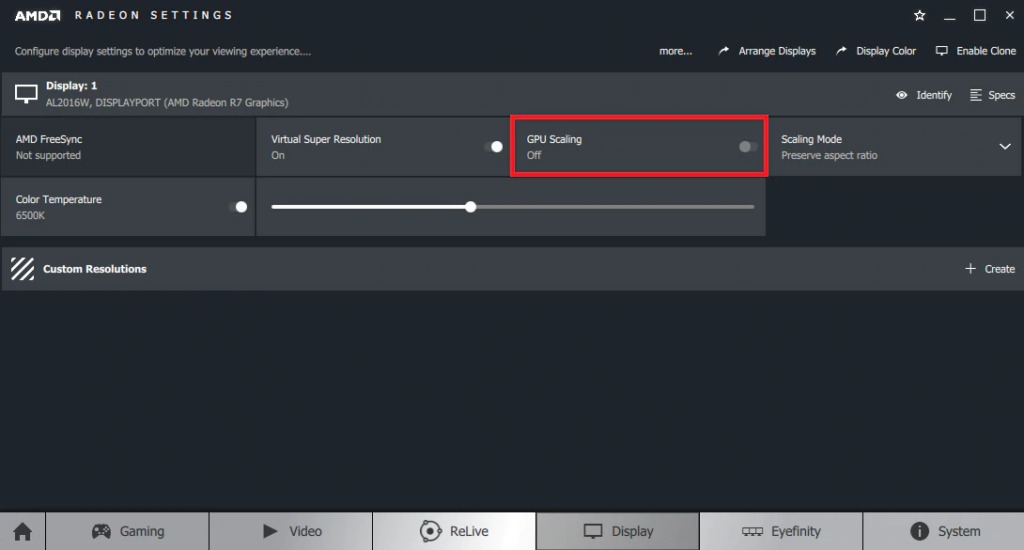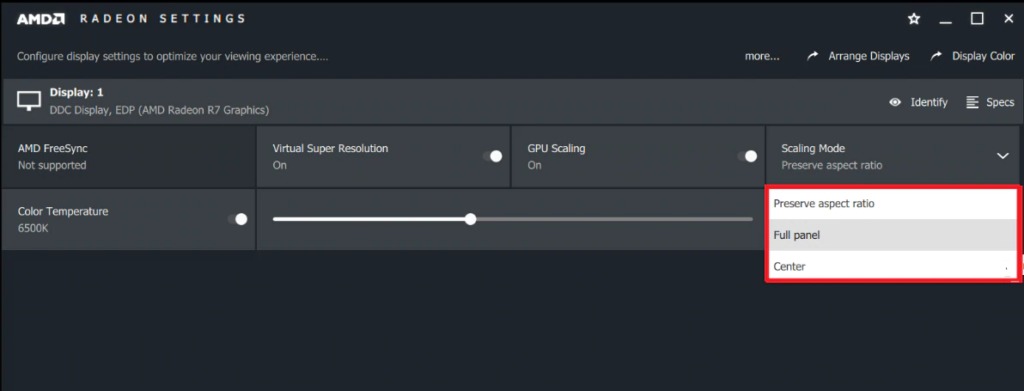A GPU is a computer processor that is assigned the task to create on-screen images, to make videos and games more fun and exciting. All gaming enthusiasts always want the best display quality that can enhance their visuals and double up the gaming experience. With the advancement in technology, almost everything is possible nowadays and improving graphic quality in your monitor is just a petty task.
GPU Scaling is a technical feature that helps you in achieving high-quality image output. It allows you to make adjustments on the aspect ratio of a game based on your monitor’s resolution and thus gives you the experience of fine-tuned graphics and image output regardless of the monitor resolution.
For example, older games that were designed for past era monitors run on lower aspect ratios of 5:4 or 4:3 will stretch the images on a 16:9 screen setting producing stretched, blurred and very poor image quality. GPU Scaling comes in rescue here, it adjusts the images and effectively fits it both horizontally and vertically on the screen without pixelating the images.
Most of the gamers usually have an AMD graphics card; in that case, you have to adjust the GPU Scaling option via AMD Catalyst or AMD Radeon Graphics. Other makes-aside from AMD also allows GPU Scaling. We will discuss all the steps to enable GPU Scaling in different makes of monitors. Let’s first know why you exactly need GPU Scaling.
Table of Contents
Why do you need GPU Scaling?
If you are a gaming enthusiast you must be into indie or old era games that usually run in a 5:4 or 4:3 aspect ratio or applications that run on such aspect ratios and as you’re using a 16:9 or 16:10 screen, the resulted overall graphic output of such images will be of very poor quality and pixelated. GPU Scaling plays a very important role here by adjusting the aspect ratio according to the screen resolution. It rectifies a disparity in the aspect ratio that is an image’s width relative to its height between the image created by a software application or a game and adjusts it according to the screen’s resolution to create smoother playback.
Imagine the scenario, you’re playing a basketball game and the point guards look more like defensive tackles on the football field that an important part of basketball, wouldn’t that be irritating? This is why GPU Scaling is useful for you; it alters the aspect ratio of the image to make them look good on widescreen monitors and displays.
Types of GPU Scaling
There are basically three different modes in GPU Scaling that can be adjusted via AMD Catalyst or AMD Radeon Graphics.
1. Maintain Aspect Ratio
As the name can suggest a lot about this mode, maintain aspect ratio allows you to experience the best graphics by preserving the real aspect ratio. It doesn’t alter the aspect ratio and instead adds black bars at the top and bottom, or at the left and right of your display to fill the excess background.
2. Scale Image to Full Panel Size
This mode can make the screen look weird as it stretches the image to fill the screen entirely which results in poor image output and bad graphics as the game former aspect ratio is not followed as it should be. This mode will help you to run your favorite game on your monitor but the stretched and poor screen output can be irritating and painful for eyes.
3. Use Centered Trimmings
The third mode in GPU Scaling also works wonders for gamers as it doesn’t disrupt the aspect ratio and turns the scaling off by placing the original screen resolution of the image in the center of the display. This is very useful when the image is smaller than the screen’s resolution. The bare background is filled up with black bars or a background pattern.
How to enable GPU Scaling?
If you want to enable GPU Scaling within the Radeon Settings, there are few conditions that you’ve to fulfill. Without these formalities, you’ll not be able to use the GPU Scaling option.
- This process requires a digital connection that includes DVI (Digital Visual Interface), HDMI (High-Definition Multimedia Interface) or the mini DisplayPort/DisplayPort. You cannot enable GPU Scaling without the presence of these digital connections.
- The second requirement is the newest graphics driver that is supported by your graphics product. If you don’t have such a driver, you’ve to install one in your device.
- You have to set the display of your screen to its native resolution and refresh rate. Adjustment of the display brightness is also necessary.
After you’ve fulfilled all the requirements, now it’s time to learn how to enable GPU Scaling!
- Right-click on the desktop and click on the ‘AMD Catalyst Control Center’.

- Click on ‘My Digital Flat-Panels’ option that is located at the left-hand sidebar.
- Several options will appear under ‘My Digital Flat-Panels’. You’ve to choose and click on the ‘Properties (Digital Flat-Panel)’ option from that list.
- Now a page will appear with many options, from that Click on the checkbox beside ‘Enable GPU up-scaling’ to turn it on or uncheck it to turn it off.

- Below that you’ll also find the ‘Preferred Scaling Mode’, select your desired option and click ‘APPLY’

VOILA! It’s done.
Can we remove the black bars?
The black bars appear on the background of your screen when you enable GPU Scaling in your monitor. The mismatch between scaling and the GPU process of analyzing the image results in these black bars around the image to cover the excess background.
Removing these black bars completely from your screen is not actually possible but there’s a feature named UNDERSCAN/OVERSCAN in GPU Scaling that can adjust the image accordingly to get better output. Let’s know more about that feature!
Underscan/Overscan
Underscan/Overscan is an option that can be found in the configuration menu of most GPUs. Some GPUs setting also use different names for this similar option so, it actually varies from GPU to GPU but all of them serve the same function.
A lot of mismatches occur in the process of your GPU analyzing and scaling the image as you’re trying to use a native 4:3 or 5:4 aspect ratio on a new monitor with a more popular aspect ratio such as 16:9. This results in black bars surrounding the image from all sides or sometimes the image is cut off because it goes beyond the edges of the screen. The feature Underscan/Overscan can be used here as it allows you to adjust the size of the image for a comfortable view. You can shrink or enlarge the image to get the perfect fit according to your screen size.
Are there any cons of using GPU Scaling?
This far we have just discussed the good points of GPU Scaling but the truth is that it also comes with a few petite issues that can seem a big drawback. First of all, as it is already very clear that GPU Scaling is for older games, there is no point in using this setting for the latest games. It can create unnecessary performance issues in your game such as input lag.
Now, input lag isn’t something that you’ll only face with the newer games but you’ll also face in games that use a native 4:3 or 5:4 aspect ratio. Why is it so? Let’s find out!
Input Lag
Input lag basically is the delay that is experienced between the resulting on-screen action and clicking the button during a game or video. It interrupts the ability to act or play quickly within the game and also disrupts the smoothness of the video. Using the GPU Scaling feature needs more processing and thus creates a slight input lag.
Although this takes just a fraction of seconds and is completely unnoticeable in videos but when you’re playing a game this can be very evident and affects your gaming performance. Now, input lag again varies from monitor to monitor. You’ll experience the lowest input lag in the best gaming monitors that are used for competitive gaming. In this case, you’ve to decide what is more bearable for you! Input lag or not scaling the image?
Another point that can be considered a drawback is that sometimes display scaling may be preferred over GPU scaling. It can be seen in situations where it comes to benchmarking the lower-than-native resolution performance in games.
Conclusion
This is now very clear that GPU Scaling can enhance your gaming performance by having higher resolution and better graphics that make the images more vivid and realistic. But you’ve to deal with the black bars and input lag.
You can enable GPU Scaling for all your favorite old era games and make a few adjustments yourself to get the desired fit on the screen.
Most of the time, GPU Scaling is self disabled for games that run on the same resolution as the monitor, enabling GPU Scaling for these games is useless as it will just create more input lag and will affect your gaming performance.
The final decision lies in your hand! If you really think that GPU Scaling is useful for you, you can enable it by following the above steps or if you’re not comfortable with the input lag, you can find other ways to play the old video games.
If you’ve any more queries related to GPU Scaling, you can drop a message in the comment box and we’ll get back to you!
Leave a Reply